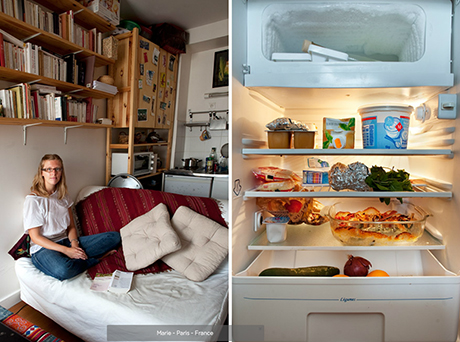
IMAGE: Marie – Paris – France, from the In Your Fridge series by Stéphanie de Rougé.
Photographer Stéphanie de Rougé wanted to shoot a series of intimate portraits of New Yorkers framed by their most personal context. She started by taking photographs of her subjects in their bedrooms, but found that, because New Yorkers rent, sublet, and move so frequently, “the building walls don’t talk.”
A couple of people suggested that their personal sanctuary in the city was up on the roof, so de Rougé made a series of forty photographs of people in their high-rise oases, from charity-shop couches perched on waterproof rubber membranes to full-blown roof-deck tiki bars.
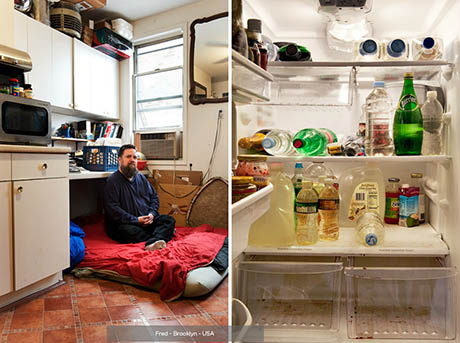
IMAGE: Fred – Brooklyn – USA, from the In Your Fridge series by Stéphanie de Rougé.
But when she got thirsty on one shoot, helped herself to a juice from the fridge, and discovered a naked Barbie doll nestled among salad ingredients, she discovered her next series: In Your Fridge (or L’Ego au Frigo, to give its more poetic French title). She knew she had finally hit gold when a quarter of her subjects refused to let her photograph their refrigerators, excusing themselves by suggesting she come back later, after they had been shopping or cleaned up.
It takes a lot of courage to say no to a photographer who is already there, set up with her tripod, lights, and gear, de Rougé told Montreal-based newspaper Le Devoir. Clearly, the fridge is one of the most personal spaces in a home.
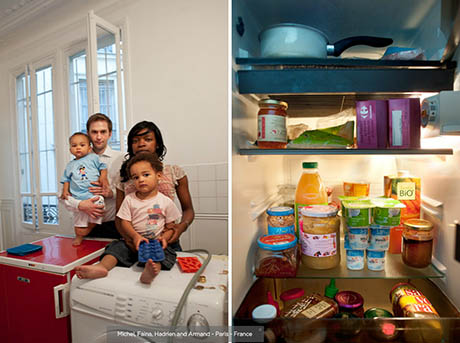
IMAGE: Michel, Faina, Hadrien and Armand – Paris – France, from the In Your Fridge series by Stéphanie de Rougé.
Nonetheless, a few brave souls agreed to open their refrigerator door for de Rougé, who presented her subjects and the contents of their refrigerator side-by-side.
The resulting diptychs make an interesting contrast to photographer Mark Menjivar’s earlier series of fridge portraits, You Are What You Eat (previously featured on Edible Geography), in which Menjivar eliminates the photograph of the appliance owner altogether, simply captioning their refrigerator interiors with a sentence of biography instead.
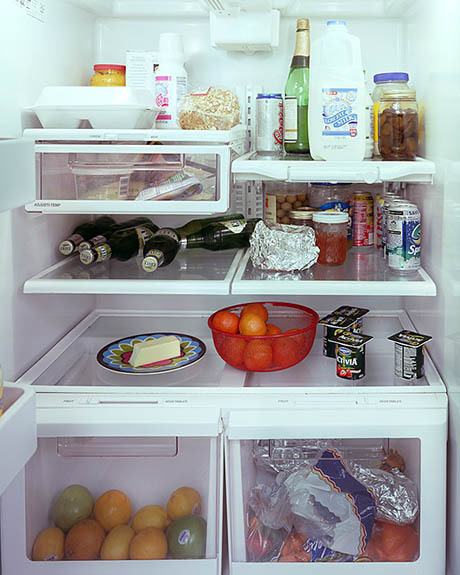
IMAGE: Community Volunteer | San Angelo, TX | 1-Person Household | Completely blind and lives alone. | 2007, from the You Are What You Eat series by Mark Menjivar.
De Rougé shot the series in New York and in Paris. As The Guardian, where I found this series, comments, “You might think you could draw lazy conclusions about the food-loving French and takeaway-mad New Yorkers — and you’d be mostly right.” De Rougé told Le Devoir that she found more than one New York fridge with nothing edible in it, whereas that was never the case in Paris.
In terms of non-food items, de Rougé’s New Yorkers keep film in their refrigerators, while Aurore, a Parisian, uses it to store her silk and cashmere scarves. There were also, apparently, a lot of illegal drugs being stored in the fridges of both cities, although those photos did not make it into the series, for obvious reasons.
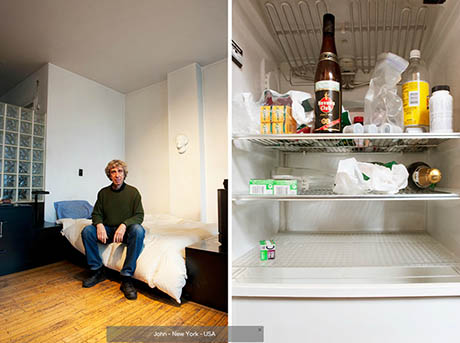
IMAGE: John – New York – USA, from the In Your Fridge series by Stéphanie de Rougé.
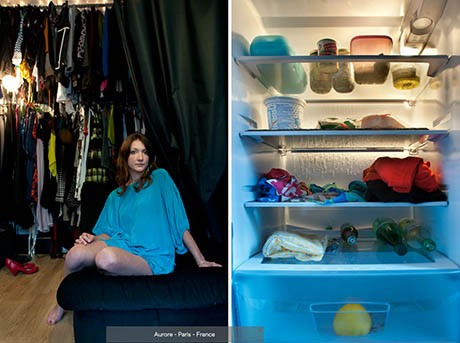
IMAGE: Aurore – Paris – France, from the In Your Fridge series by Stéphanie de Rougé.
Within its chilly, rectangular frame, the fridge offers a window on our aspirations (fresh fruit and vegetables dying a cold-slowed death in the crisper), guilty secrets (a serious Lipton Iced Tea habit), priorities, and private standards of cleanliness. Both Menjivar and de Rougé argue that when we open the refrigerator and stare aimlessly at its contents, looking for inspiration or distraction, we are often blind to its mirror-like reflection of our innermost selves.

IMAGE: Salah, Elisabeth, and Hayat – Queens – USA, from the In Your Fridge series by Stéphanie de Rougé.
Of course, I would argue that we are also oblivious to its larger importance, as a small container of the permanent, artificial winter that underpins our entire food system.
In 2011, the In Your Fridge series was exhibited in Paris and Brussels, after which de Rougé received the following, intriguing comment:
After the show, everyone in the building was talking about the fridge experience — as if they had discovered an unknown planet in their apartment.
If the domestic refrigerator is an unknown planet, then just imagine the cold storage warehouses, reefers, tank farms, and blast tunnels that join together in a vast, international constellation of astonishing properties and dimensions…
Of course, as regular Edible Geography readers will know, Matthew Coolidge of the Center for Land Use Interpretation and I have spent the past months visiting and documenting this constellation, or at least the most monumental and significant examples of the artificial cryosphere in North America. Excitingly, we’re in the final weeks of putting together our Graham Foundation-supported exhibition on the topic, to open at CLUI’s Culver City headquarters in May — stay tuned for more on the show next month.

